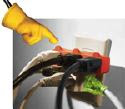Electrical Safety Tips
Parang matchsticks, ang konting spark ay pwedeng makagawa ng malaking sunog. Sabi nga din, ang kuryente ay tamad. Kung saan ang pinakamadali at pinakamaikling daanan para sa kanya, yun ang kanyang pupuntahan.
It tries to find a conductor, or something that it can pass through to get to the ground, like metal, wet wood or water. Your body is about 70% water, so that makes you a good conductor, too. For example, if you touch an energized bare wire or faulty appliance while your feet are touching the ground, electricity will automatically pass through you to the ground, causing a harmful, or even fatal shock.
It only takes one mistake to spark an electrical fire, but simple prevention measures can be effective solutions.
1) APPLIANCES


It tries to find a conductor, or something that it can pass through to get to the ground, like metal, wet wood or water. Your body is about 70% water, so that makes you a good conductor, too. For example, if you touch an energized bare wire or faulty appliance while your feet are touching the ground, electricity will automatically pass through you to the ground, causing a harmful, or even fatal shock.
It only takes one mistake to spark an electrical fire, but simple prevention measures can be effective solutions.
1) APPLIANCES

- Unplug unused appliances and stow cords safely out of reach of pets, young children or hazardous situations.
- Appliances that generate heat, such as clocks, televisions and computer monitors, should be given several inches of clearance all around for good air circulation and cooling. Do not drape clothes, toys or other items over warm appliances.
- Always follow appliance instructions carefully, and do not attempt amateur repairs or upgrades.
- Keep all electrical appliances away from water such as sinks, bathtubs, pools or overhead vents that may drip.
- Do not operate any electrical appliance with wet hands or while standing in water.
Cords
Every electrical appliance has a cord, and many homes use extension cords to increase the range of electrical outlets. Ito naman ang mga dapat tandaan pagdating sa mga electrical cords.
- Check cords regularly for frays, cracks or kinks, including power tool cords, holiday lights and extension cords.
 Cords are not be jump ropes, clothes lines or leashes, and should never be used for anything other than their intended purpose.
Cords are not be jump ropes, clothes lines or leashes, and should never be used for anything other than their intended purpose.
- Cords should be firmly plugged into outlets – if the cord is loose and can pull out easily, choose a different, more snug outlet.
- Do not staple or nail cords in position at any time; if the cord does not remain where desired, use tape or twist ties to secure it.

- Cords should not be placed beneath rugs where they can become a trip hazard or where frays will not be noticeable. Furthermore, covering a cord will prevent it from keeping as cool as possible.
- Do not make modifications to a cord’s plug at any time – do not clip off the third prong or attempt to file down a wider prong to fit in a different outlet.
- Extension cords are a temporary solution only and their use should be minimized whenever possible.
Outlets
Every cord has to plug into an appropriate electrical outlet, but these tempting niches are inviting to unwelcome objects that can cause shorts and fires. Use these electrical safety tips at home to keep outlets safe.
- Block unused outlets by changing to a solid cover plate or using childproof caps.
- Do not overload outlets with multiple adaptors or power strips; relocate cords instead.
- Never put any object other than the appropriate size plug into an outlet.
- Install ground fault circuit interrupter outlets in potentially hazardous areas such as near pools, crawlspaces, kitchens, bathrooms and unfinished basements.
- Keep all outlets properly covered with secure plates that cover all wiring.
Light Bulbs
Light bulbs are the single most common electrical fixture in homes, and proper light bulb safety can keep them from becoming a common electrical hazard.
- Use bulbs that have the correct wattage requirements for each fixture -- using a higher wattage bulb c
 an cause the fixture to overheat.
an cause the fixture to overheat.
- Consider switching to more efficient compact fluorescent bulbs that provide the same level of light at a lower wattage level.
- Always screw bulbs in tightly; a loose bulb can cause sparks or shorts.
- Be sure to unplug or turn off a fixture completely before changing light bulbs.




No comments:
Post a Comment